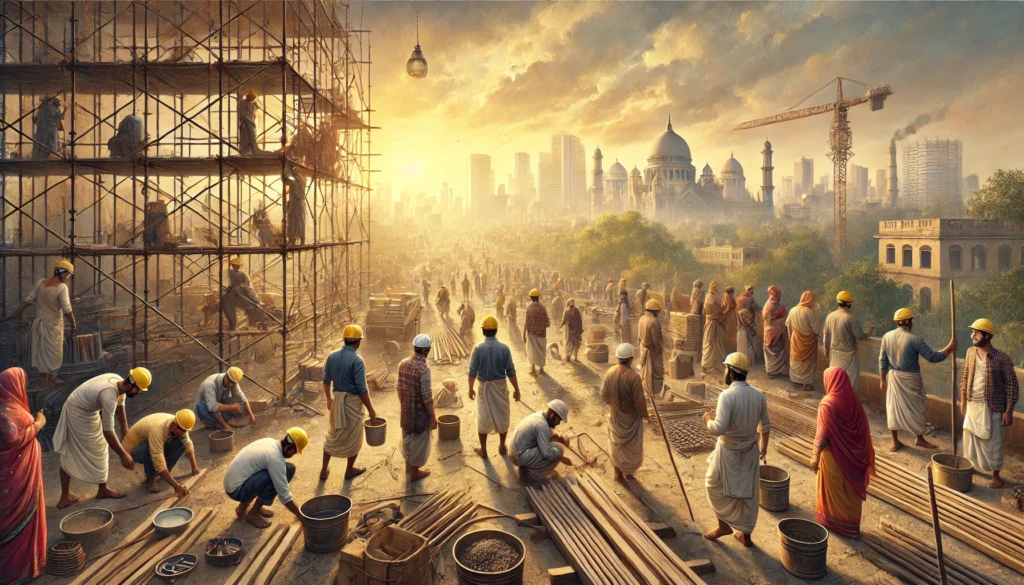Published on 20th April 2025
Authored By: Anisha Coutinho
Lords Universal College of Law, Mumbai University
Introduction
For the worst crimes, the death sentence is meant to be the final punishment. But in reality, it is frequently enforced unevenly, with leniency and court delays enabling criminals to avoid severe punishments. This calls into question both its function in guaranteeing victims’ justice and its efficacy as a deterrence.
The death penalty in India is still under investigation for sentence inequalities, execution delays, and compliance with international human rights norms, despite the Supreme Court’s stringent restrictions for its implementation. The legal system, judicial tendencies, and human rights issues related to the death penalty in India are all examined in this article.
Literature Review
The effects of the death penalty in India have been the subject of much discussion among academics and legal professionals. Research shows that death row inmates are subjected to socioeconomic inequalities, protracted execution delays, and inconsistent judicial decisions:
- The National Law University’s Death Penalty India Report (2016) revealed that many death row inmates come from lower socioeconomic backgrounds, raising concerns about access to quality legal representation.
- Amnesty International (2021) reported that socioeconomic factors cause marginalized communities to be disproportionately represented on death row.
- The Law Commission of India (2015) recommended abolishing the death penalty for all crimes except those related to terrorism, citing its irreversible nature and the risk of wrongful convictions.
- In order to ensure fair trials and humane treatment of convicts, the United Nations Human Rights Committee (2022) underlined that India’s use of the death penalty should conform to international human rights norms.
Globally speaking, nations like China, Saudi Arabia, and Iran use the death penalty for serious crimes in order to uphold justice and discourage such acts in the future. The United Kingdom, Canada, and the majority of Europe, on the other hand, have abolished the death penalty on the grounds that it has no discernible effect on crime rates. According to studies, countries with stringent legal systems and life in prison without the possibility of release frequently have comparable deterrent effects without the moral and ethical conundrums that come with the death sentence.
The intricacy of the death penalty is highlighted by this continuing discussion, which strikes a balance between deterrent and issues of justice, equity, and human rights.
History of Death Penalty in India
In the past, the default penalty for murder was the death penalty. In order to implement a more restorative approach to justice, life in prison eventually took its place. On September 9, 1947, Rasha, also known as Raghuraj Singh, was executed at Jabalpur Central Jail in the first execution ever documented in independent India.
Early legal documents in ancient India are where the death sentence was first used:
- The Dharmashastras described penalties for transgressions of moral and caste laws, some of which included the death penalty;
- Kautilya’s Arthashastra recommended the death penalty for certain crimes, such as treason and violent offenses.
- The king’s need to protect his subjects was underlined in the Smritis of Manu and Yajnavalkya, which supported the death penalty for criminals.
Despite this lengthy history, Buddhist ideas, which are generally against the death penalty—have also impacted Indian justice thought. Buddhism emphasizes the possibility of human transformation over punitive methods and supports rehabilitation rather than retribution. India’s Present Situation India has one of the lowest execution rates in the world today. Although the death penalty is still permitted, it is only used in extremely rare circumstances due to rigorous judicial criteria.
Legal Framework of the Death Penalty in India
The Indian Penal Code (IPC), the Code of Criminal Procedure (CrPC), the Indian Constitution, and most recently the Bharatiya Nyaya Sanhita (BNS) 2023 are among the laws that regulate the death sentence in India. These laws specify the crimes that carry the death penalty, the sentencing guidelines, and the rights of both the accused and the victims.
- The death penalty is stipulated in both the Indian Penal Code (IPC) and the Bharatiya Nyaya Sanhita (BNS) 2023 for serious offenses like murder (Section 302), waging war against the state (Section 121), and specific rape instances (Section 376A). The BNS 2023 proposes changes to improve victim compensation, guarantee fair trials, and fortify legal protections.
- Code of Criminal Procedure (CrPC): Section 354(3) emphasizes judicial discretion in sentencing by requiring courts to give “special reasons” for applying the death penalty.
- Indian Constitution: Although Article 21 protects the right to life, courts have maintained the death penalty where it is administered in accordance with due process.
- Juvenile Justice (Care and Protection) Act, 2015: This law prioritizes rehabilitation over retaliation and exempts minors from the death penalty.
- Domestic Violence Act, 2005: This law addresses crimes that carry harsh sentencing if they result in fatalities, even if it does not specifically call for the death sentence.
- The 1989 Scheduled Castes and Scheduled Tribes (Prevention of Atrocities) Act: This law imposes harsher punishments, such as the death penalty, for offenses against underprivileged groups.
These laws address victim compensation, provide safer norms and regulations to deter crime, and regulate the consequences and punishments for crimes. The legal system is always developing to reflect the shifting views of society on punishment and justice.
Judicial Trends on the Death Penalty
Strict rules have been developed by Indian courts to control the application of the death penalty and guarantee that it is only given in extreme circumstances.
- The Doctrine of “Rarest of Rare”
The “rarest of rare” theory was established by the Supreme Court in Bachan Singh v. State of Punjab (1980)[1], which held that the death penalty should only be applied in cases where alternative sentence is clearly insufficient. In Macchi Singh v. State of Punjab (1983), the doctrine was further developed, distinguishing elements including the type of crime, the motive, the manner, and the impact on society. Heinous acts like rape are nonetheless punished lightly in spite of this theory. According to research, rapists frequently obtain bail or a sentence of minimal incarceration, only to commit crimes again after being freed. In these situations, stricter application of the “rarest of rare” theory is required to prevent recurrent crimes and guarantee victims’ justice.
- Sentencing discretion and irregularities
Inconsistencies in punishment have resulted from judicial discretion. Convicted murderers and rapists have occasionally been released on bond, enabling them to commit crimes again. One man, for instance, was freed after being found guilty of raping a five-year-old in the early 2000s, but he later raped a nine-year-old child in 2011. He later committed another rape after being imprisoned once more and then freed. These cases demonstrate the perilous effects of judicial tolerance, as offenders become increasingly adept at taking advantage of the system’s unwillingness to apply the death penalty.
- Mercy petitions and execution delays
Crime rates rise as a result of repeated delays in carrying out death sentences. The deterrent power of the death penalty is diminished by protracted legal disputes, mercy requests, and administrative inefficiencies that frequently lead to indefinite postponements. An excellent example is the Nirbhaya case, in which the execution of the convicted individuals was postponed for years in spite of convincing evidence and a death sentence that had been confirmed. The conviction of Dhananjoy Chatterjee (2004) for the 1990 rape and killing of 18-year-old Hetal Parekh is another noteworthy case. He became the first person to be hanged in India in the twenty-first century on August 15, 2004, fourteen years after he was executed in spite of several appeals and pleas for mercy. Discussions of whether prolonged confinement prior to execution qualifies as cruel and inhumane punishment were triggered by his protracted stay on death row. This case demonstrates how needless delays not only increase the prisoner’s suffering but also prevent victims and their families from receiving prompt justice.
Human Rights Concerns and Global Perspective
- Possibility of False Convictions
Justice is frequently subordinated to procedural considerations in the legal system. For instance, a 19-year-old youth was accused under the Terrorist and Disruptive Activities (Prevention) Act (TADA) in the Mohammad Nisaruddin Case[2]. After he was given a life sentence by the Ajmer Court, the matter was brought before the Supreme Court. After he had already served 23 years in prison on bogus charges, the Supreme Court dismissed all of the charges against him. Additionally, the court did not compensate him in spite of his erroneous conviction.
- Accusing the Victim of Being the Victim
Even in the twenty-first century, society’s perceptions of victims are still outdated. Society frequently places the blame on victims rather than criminals. Although a 17-year-old was under the influence of alcohol when he assaulted a five-year-old girl in the Shivpuri rape case, the focus of the conversation was on unrelated details like the girl’s attire. This is a reflection of ingrained misogyny and the inability of judicial systems to safeguard the defenceless.
- Capital Punishment for Serious Offenses
People don’t take the death sentence for horrible crimes seriously enough. The court system’s startlingly mild stance in the Nirbhaya case caused the sentencing to be postponed.
One of the defendants in the Nirbhaya case recently committed a new crime, attacking a different woman and saying in an interview, “She did not scream.” This demonstrates how the legal system has failed to stop recurrent crimes by seasoned offenders.
Another obvious example is the Terrorist Attack on the Taj Mahal Palace, in which it took years for Ajmal Kasab to be apprehended, tried, and executed. In addition to delaying justice, these delays give prospective criminals more confidence when they perceive weaknesses in the system.
The Death Penalty’s Social and Psychological Aspects
The death penalty has a psychological toll on victims and society at large in addition to death row inmates. Victims of horrible crimes frequently experience lifetime suffering as a result of justice delays, while criminals awaiting execution face protracted uncertainty. In certain situations, victims who feel abandoned by the legal system commit tragic suicides as a result of emotional hardship, social humiliation, and delayed sentence.
According to research, compared to 9.4% of non-victims, 25% of crime victims suffer from PTSD throughout their lives. Furthermore, 31% of rape victims get PTSD, which is 6.2 times more common in these women than in those who have never experienced abuse. Major depressive illness affects 36.6% of people with PTSD, indicating that depression is also common. Furthermore, compared to non-victims, rape victims are 13 times more likely to have attempted suicide and four times more likely to have thought about suicide.
Additionally, lengthy legal battles worsen the psychological agony endured by the relatives of the accused and the victim. Moral issues are also brought about in society by the emotional burden of the death penalty and the fear of a wrongful execution. Justice must be prompt, equitable, and proportionate in order to be meaningful. It must also protect the rights of both accused and victims while avoiding unnecessary suffering.
Racial and Socio-Economic Bias in Sentencing
Racial and Socioeconomic Bias in Sentencing Research indicates that in India, caste, poverty, and religious affiliation are major factors in determining who receives a death sentence. 76% of death row inmates in India are members of Scheduled Castes (SC), Scheduled Tribes (ST), Other Backward Classes (OBC), or religious minorities, according to the NLU’s 2016 Death Penalty India Report.[3]
The report’s main conclusions were as follows:
- Caste and Religion as a Factor: Systemic prejudices in the legal system are evident in the disproportionate number of people who get death sentences from marginalized backgrounds.
- Lack of Access to Good Legal Counsel: Because many death row inmates are impoverished and illiterate, they cannot afford knowledgeable attorneys, which results in unfair trials and erroneous convictions.
- Regional Differences: The proportion of marginalized people given death sentences is higher in some states, including Uttar Pradesh, Madhya Pradesh, and Bihar.
- Delayed Justice: People from less socioeconomic backgrounds are more likely to be kept on death row since their mercy requests are not as likely to be granted.
Implications of These Findings
There are questions regarding the fairness and justice of the death penalty because the disadvantaged are disproportionately punished by the legal system.
Richer people are more likely to obtain lighter punishments because they have greater legal resources when they are charged of identical offenses.
Judicial changes are necessary to guarantee equitable access to justice and stop discrimination in death penalty cases based on caste and class.
Human Rights and Justice: A Critical Perspective
While communal tensions continue to dominate national discourse, the real issue rising crime, remains overlooked.
On March 6, 2025, Bibhas Nayak, a 29-year-old youth, sacrificed his life protecting two women from being raped, yet his attackers remain unpunished, lost in a system more focused on political narratives than justice. Meanwhile, leaders and factions fuel religious discord instead of addressing such heinous crimes.
In another disturbing instance, a viral Instagram reel exposed how women bathing at the Mahakumbh were secretly filmed, with their videos being illegally sold online[4].
Do these crimes not pose a grave threat to society and demand immediate action? If human rights are invoked to protect criminals from the death penalty, should they not be equally upheld for victims? Justice must not be one-sided—victims, too, have fundamental rights, including the right to justice. A legal system that prioritizes the rights of criminals over the suffering of victims undermines its moral and ethical foundations. True justice demands that the rights of victims be upheld with the same intensity as those of the accused.
A striking paradox in the debate over capital punishment is the selective outrage of human rights advocates. Why is it that human rights organizations protest when criminals receive the death penalty, yet remain largely silent when victims endure unimaginable suffering? Justice must not be one-sided victims, too, have fundamental rights, including the right to justice. A legal system that prioritizes the rights of criminals over the suffering of victims undermines its own moral and ethical foundations. True justice demands that the rights of victims be upheld with the same intensity as those of the accused.
A Perpetuation of Violence or a Needed Deterrent: The Death Penalty?
The usefulness of the death penalty as a deterrence is still a hotly debated topic. While some contend that the death penalty deters crime by making potential criminals fearful, others contend that it just serves to reinforce injustice and violence. For serious crimes, nations like Saudi Arabia, Iran, and China firmly implement the death sentence in order to provide victims with justice and discourage similar acts in the future. According to the Retributive Theory of Punishment, which is based on the idea of “an eye for an eye,” offenders need to endure the same degree of suffering as their victims did.
But in reality, the legal system frequently fails. Criminals are able to avoid severe punishment by obtaining bail or reduced sentences due to political pressure, corruption, and legal loopholes. Instead of discouraging crime, this sentence irregularity encourages it and erodes public confidence in law enforcement.
One notable instance is the Pune Porsche case, in which two young people were killed after they were struck by a car driven by a minor. The minor was given a simple assignment to write an essay about road safety instead of a harsh punishment, which infuriated the public. Such lenient decisions give the families of victim’s little justice and send a disturbing message: criminals may get away with serious crimes, which feeds into the perception that the legal system is unaccountable.
Crime becomes a vicious circle when criminals are consistently given light punishments. When criminals discover that the system is lenient, they resume their previous behaviours without worrying about severe repercussions. Because it ensures that those who perpetrate the most horrible crimes face irrevocable repercussions, the death penalty acts as a necessary deterrent, protecting society from repeat offenders and upholding the principle of justice.
Guidelines and Suggestions Regarding Death Penalty
- Strict Enforcement for Serious Offenses:
To achieve justice and discourage future crimes, the death sentence should be firmly enforced to rape, terrorism, serial homicides, and crimes against minors.
- Fair and Transparent Investigations:
To avoid wrongfully convicted individuals, law enforcement must carry out unbiased investigations. Officers who falsify evidence or force confessions must answer for their actions.
- Prompt and Equitable Justice:
Article 21 must safeguard victims by guaranteeing that perpetrators receive prompt and proportionate punishment, even as it protects the right to life.
- Accelerated Judicial Process:
To guarantee prompt justice, courts must set clear sentence guidelines, restrict pointless appeals, and expedite capital cases.
- Tougher Review of Mercy Petition:
In order to avoid unnecessary delays, mercy petitions should be closely examined. Criminals found guilty of planned, horrible atrocities must not take advantage of legal loopholes to evade punishment.
Conclusion
In India, the death sentence needs to balance human rights, deterrence, and justice. Delays and uneven sentences lessen its impact, even though the “rarest of rare” criterion restricts its application. The public’s confidence in the legal system depends on stricter sentencing criteria, quicker appeals, and increased judicial transparency.
“Justice delayed is justice denied.” India must make sure that the death penalty is administered equitably and effectively in order to uphold justice in a responsible manner.
References
- Mahawar S, ‘The Case of Dhananjoy Chatterjee: A Noteworthy Lesson for the Judiciary’ (iPleaders, 18 November 2021) <https://blog.ipleaders.in/case-dhananjoy-chatterjee-noteworthy-lesson-judiciary/#Facts_of_the_case> accessed 13 March 2025
- ‘Mumbai Terrorist Attacks of 2008’ (Encyclopædia Britannica, 15 February 2025) <https://www.britannica.com/event/Mumbai-terrorist-attacks-of-2008> accessed 13 March 2025
- Pti, ‘Pune Porsche Car Accident: Bail to Minor Accused; Two Members of Juvenile Justice Board Removed’ (The Hindu, 10 October 2024) <https://www.thehindu.com/news/national/maharashtra/pune-porsche-car-accident-bail-to-minor-accused-two-members-of-juvenile-justice-board-removed/article68740211.ece> accessed 14 March 2025
- Hrusikesh Mohanty / Mar 11 2025, ‘2 Days before Death, Bibhas Promised to Meet Mom: Bhubaneswar News’ (The Times of India) <https://timesofindia.indiatimes.com/city/bhubaneswar/2-days-before-death-bibhas-promised-to-meet-mom/articleshow/118894569.cms> accessed 15 March 2025
- Meyer JF, ‘Retributive Justice’ (Encyclopædia Britannica, 19 February 2025) <https://www.britannica.com/topic/retributive-justice> accessed 15 March 2025
- https://indiankanoon.org/doc/1235094/
- https://www.thehindu.com/news/cities/mumbai/prisoners-of-the-system/article17333262.ece
- https://www.project39a.com/death-penalty
- https://www.cnbctv18.com/india/mahakumbh-women-secretly-filmed-bathing-leaked-videos-sold-online-uttar-pradesh-police-facebook-instagram-19562274.htm




